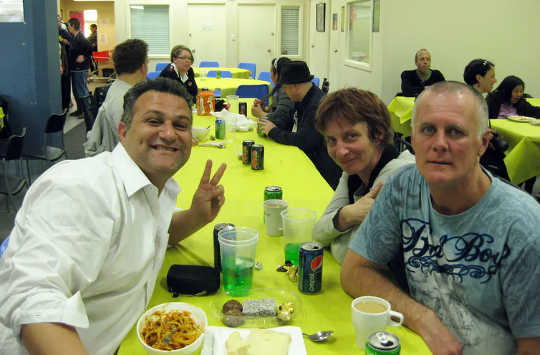
Pasta and bolognese sauce were on the menu provided at this Sydney venue by not-for-profit organisation Foodbank.
From their inception in the early 1990s, Australian food banks were supposed to be a temporary solution to food poverty.
They have since morphed from “emergency to industry” – lauded for reducing food insecurity and helping to solve the food waste problem by diverting tonnes of produce from landfill.
It’s the ultimate win-win that big food corporations and retailers love: feed the needy and save the planet at the same time. This logic has been enshrined in Canada’s National Food Waste Reduction Strategy and in European laws that require supermarkets to donate surplus produce to charities.
Can foodbanks end food insecurity?
As Martin Caraher has suggested on The Conversation, we argue that food banks “depoliticise hunger” and address symptoms rather than causes.
Laudable and regrettably necessary as their work is, food banks are a band-aid solution for a patient – contemporary society – suffering from what John McMurtry evocatively terms “the cancer stage of capitalism”. We are seeing ubiquitous and intensifying inequality, brought about by decades of dogmatic adherence to market fundamentalism.
If we are serious about tackling the causes of food insecurity, we must turn away from neoliberalism to an inclusive and values-based political economy. And if we are serious about ending food waste, we need a “paradigm shift” away from productivism towards a food system “designed for well-being, resilience and sustainability”.
From emergency to industry
According to Foodbank Australia’s 2017 Hunger Report, 625,000 Australians are seeking emergency food relief every month. That’s a 10% increase on the previous 12 months.
Despite their rapid expansion, food banks are unable to meet the demand produced by stagnating wages, rising costs of living and a shrinking welfare state. They have been called “highly visible successful failures”. As well as stepping into the state’s shoes to provide a minimal social security safety net, they offer very useful services to food manufacturers and retailers.
First, they divert millions of tonnes of waste from landfill. Food donors save considerable sums in disposal charges.
Second, donors receive tax deductions for all produce donated to food banks, which are registered charities. And, perhaps most significantly, donors can enhance their social licence to operate as good corporate citizens and receive cheap publicity into the bargain.
Band-aids, not solutions
In a recent paper for the UK Food Research Collaboration, Martin Caraher and Sinead Furey undertook a cost-benefit analysis of the current consensus that food insecurity is best addressed by increasing donations of surplus food to food banks. Their conclusion was unequivocal:
While there are benefits to diverting surplus food away from landfill, the reasons for pessimism outweigh the reasons for optimism. This is because the benefits of using food waste to feed people accrue primarily to the food industry, whilst absolving responsibility of the government to address food insecurity.
This is of particular concern in a liberal democracy such as Australia that professes to be committed to the principle of universal human rights, including the right to adequate food. Research in the Netherlands and Scotland has confirmed the humiliation, shame and loss of dignity experienced by food bank users.
Dignified access to good food is a fundamental component of the human right to adequate food. Feeding people food waste directly undermines this right.
Reframing the debate
The dominant win-win approach that says we can solve food insecurity by diverting food waste into food banks is patently failing. Both phenomena are increasing. In any case, a state of food security is not achieved via emergency food relief.
A breakthrough was achieved on March 25, 2015, when leading community food organisations and food security researchers in Canada issued the Cecil Street Statement. The statement clarified that food insecurity was due to inadequate income and the solution lay in people having enough money to buy good food in a dignified way. Further, it stated that the conflation of food insecurity with food waste was unhelpful and counterproductive.
In Australia, the Right to Food Coalition last year issued a position statement, The Human Right to Food. This included a detailed set of recommendations, drawing on the work of the United Nations special rapporteur on the right to food.
These recommendations specified the actions required from all levels of government, as well as industry, philanthropical and community organisations. The statement called on the federal government to:
-
adequately finance income support payments so that all Australians can access a weekly basket of healthy foods
-
ensure that initiatives to rebuild local food systems are adequately supported.
What is the solution?
Broadly, what’s needed is a paradigm shift towards sustainable, healthy, resilient and rational food systems. The International Panel of Experts on Sustainable Food Systems (IPES) has clearly articulated the pathways towards such systems.
The principal barriers to such systems, according to the experts, reside in excessive concentration of political and economic power in the hands of mega-food corporations. This is documented in the new IPES report, Too Big to Feed.
In the words of visionary UK economist Kate Raworth, the necessary paradigm shift begins with a reframing of our societal priorities, away from the mantra of “an economy that grows regardless of whether we thrive” and towards “an economy that enables us to thrive regardless of whether it grows”.
About the Authors
Nick Rose, Lecturer, William Angliss Institute and Susan Booth, Casual Academic, College of Medicine and Public Health, Flinders University
This article is republished from The Conversation under a Creative Commons license. Read the original article.
Books on Inequality from Amazon's Best Sellers list
"Caste: The Origins of Our Discontents"
by Isabel Wilkerson
In this book, Isabel Wilkerson examines the history of caste systems in societies around the world, including in the United States. The book explores the impact of caste on individuals and society, and offers a framework for understanding and addressing inequality.
Click for more info or to order
"The Color of Law: A Forgotten History of How Our Government Segregated America"
by Richard Rothstein
In this book, Richard Rothstein explores the history of government policies that created and reinforced racial segregation in the United States. The book examines the impact of these policies on individuals and communities, and offers a call to action for addressing ongoing inequality.
Click for more info or to order
"The Sum of Us: What Racism Costs Everyone and How We Can Prosper Together"
by Heather McGhee
In this book, Heather McGhee explores the economic and social costs of racism, and offers a vision for a more equitable and prosperous society. The book includes stories of individuals and communities who have challenged inequality, as well as practical solutions for creating a more inclusive society.
Click for more info or to order
"The Deficit Myth: Modern Monetary Theory and the Birth of the People's Economy"
by Stephanie Kelton
In this book, Stephanie Kelton challenges conventional ideas about government spending and the national deficit, and offers a new framework for understanding economic policy. The book includes practical solutions for addressing inequality and creating a more equitable economy.
Click for more info or to order
"The New Jim Crow: Mass Incarceration in the Age of Colorblindness"
by Michelle Alexander
In this book, Michelle Alexander explores the ways in which the criminal justice system perpetuates racial inequality and discrimination, particularly against Black Americans. The book includes a historical analysis of the system and its impact, as well as a call to action for reform.
























